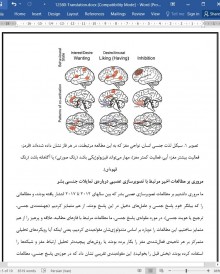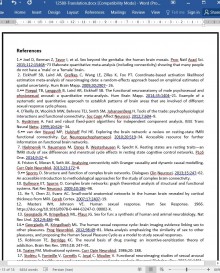
دانلود مقاله تصویرسازی مغز از پاسخ جنسی: پیشرفت های جدید و مسیرهای آتی
چکیده
هدف: هدف از این بررسی، ارائه خلاصهایست جامع از آخرین پیشرفتها در زمینه مطالعهی آزمایشی مغز درباره تمایلات جنسی بشر، با تمرکز بر ارتباطات مغزی طی پاسخ جنسی.
یافتههای اخیر: الگوهای پایدار از فعالسازی مغز، برای فازهای مختلفی از پاسخ جنسی - خصوصاً در مورد فاز مطالبه- شکل گرفتهاند و تغییرات در این الگوها را میتوان به نوسانات پاسخ جنسی –از جمله به سوءکارکردهای جنسی- مرتبط دانست. بر این اساس محکم، مطالعات مربوط به ارتباطات مغز در زمینه پاسخ جنسی بشر، بهتدریج درک و شناخت بیشتری از کارکرد شبکه مغز و ساختار مربوطه به ما ارائه میدهند.
خلاصه: مطالعات مربوط به ارتباطات مغزی جنسی همچنان بسیار نوپا است. اما با پرداختن به مغز بعنوان یک اندام متصل، جوهرهی کارکرد مغز بطور دقیقتری انعکاس مییابد که درستنمایی یافتن زیستنشانها و اهداف مفید برای مداخله در سوءکارکردهای جنسی را افزایش میدهد.
مقدمه
سالهای اخیر شاهد پیشرفتهای خاصی در حوزهی تصویرسازی مغز بوده است که به پژوهشگران امکان تحلیل مفصلترِ ساختار و عملکرد مغز انسان را داده است. این رویکردهای تصویربرداریِ عصبی بهتدریج در بررسی رفتار جنسیِ انسان نیز بکار رفته است. با توجه به شیوع اختلال کارکردهای جنسیِ ناشناخته، این پیشرفتها مثبت هستند اما برای سکسولوژیستهایی که کارشان بررسی دیتای مغز نیست، شاید درک گسترهی عظیمی از نتایج پیچیده کار دشواری باشد. در این مطالعات، ما خلاصهای جامع از آخرین پیشرفتهای حاصله در مطالعات آزمایشی مغز دربارهی جنسیت انسان را با تمرکز بر پاسخ جنسی، ارائه خواهیم کرد. استدلال ما این است که رویکردهای ارتباط مغزی، نویدبخشترین رویکرد در زمینه سازوکارهایی هستند که بر پاسخ صحیح و ناصحیحِ جنسیِ انسان، حاکمند.
از فعالیت تا ارتباط
تصویربرداری عصبی در تکنیکهای مختلف برای تجسمبخشیدن به ساختار و کارکرد سیستم عصبی بکار میرود. این بررسی، تقریباً فقط به نتایج حاصله از تصویرسازی رزونانس مغناطیسی (ام آر آی) میپردازد. ام آر آیِ ساختاری اطلاعاتی دربارهی سایز، شکل و یکپارچگی بافت خاکستری (کلاسترهای سلول بدن، مثلاً کُرتکس) و سفید (گرههای آکسون) در اختیارمان میگذارد. روشهای تحلیلی نظیر مورفومتریِ مبتنی بر وُکسل (VBM) قادرند چه درون سوژهها و چه بین سوژهها، برآوردهایی اتکاپذیر از تفاوتهای حجم ماده خاکستری و/یا سفید ارائه دهند. تصویربرداریِ تانسور پخش (DTI) یک پروتکل ساختاریِ ام آر آی است که میتواند یک نقشهی ساختاری بُعدمند از تراکتهای ماده سفید (اتصالات ساختاری) در مغز بازسازی نماید. متاآنالیز کمّی میتواند مجموعه دیتاهای بسیاری را با هم ترکیب کند تا به استنباطهای اتکاپذیرتری دربارهی ویژگیهای شکلشناسیِ مغز در جمعیتهای بزرگ دست یابد. نمونهای از این، مطالعاتی است که روی مغز 1400 انسان از چهار مجموعه دیتای مختلف انجام گرفته است که نمیتواند ایدهی دوریختیِ جنسیِ واضح در مغز انسان را اثبات کند.
نتیجه و رهنمودهای آتی
تمایلات جنسی بشر به یک »هستهی جنسی»ِ واحد متکی نیست بلکه شامل تعداد زیادی کارکرد مغز است، از جمله کارکردهایی برای برانگیختگی، پاداش، حافظه، شناخت، تفکر خودارجاعی و رفتار اجتماعی. همانطور که در این مقاله و جاهای دیگر روشن شده است، نواحی از مغز که با تمایلات جنسی بشر مرتبطند، دور هستند. از این منظر، مطالعهی اتصال مغز، بسیار شهودیتر از مطالعهی فعالسازیهای جداگانه است و در واقع طی دههها، مطالعهی ماهیت اتصال بین نواحی مغز، روشی رایج در مدلهای حیوانی از رفتار جنسی انسان بوده است. در هر کسر از ثانیه، میلیاردها نورون بواسطهی سیمهای که شبکههای عصبی پیچیدهای را خلق کردهاند، با یکدیگر حرف میزنند. با درک نحوهی کار این شبکهها –به تنهایی اما ترجیحاً در ارتباط با سایر شبکهها- است که میتوان بهتدریج سازوکارهای عصبی را در کرد که عملکرد جنسی انسان را تنظیم میکنند و دلیل اختلال جنسی غیرِ اُرگانی هستند. اخیراً لزوم اتخاذ چنین رویکردی، اهمیت بیشتری در سایر حوزههای تحقیق تمایلات جنسی دارد؛ حوزههایی نظیر هویت جنسیتی/ترانسسکسوالیتی. مثلاً تحقیقی اخیراً از دیتای MRIی ساختاری به منظور تعریف مناطقی استفاده کرد که دچار کمبود ماده خاکستری بودند و آنگاه یک پروفایل کارکردی اتکاپذیر از این نواحی را با استفاده از یک دیتابیس مغزی بزرگ، ارزیابی کرد (دیتای حاصل از 7500 آزمایش مغزی بکار رفت). مشخص شد که بلحاظ ریختشناسی، نواحی تغییریافته در پدوفیلی، بلحاظ کارکردی عمدتاً با آن نواحی مرتبط است که برای پاسخدهی جنسی حائز اهمیتند، یعنی نواحی شبکههای مطالبه و علاقه جنسی. این مساله اکیداً بیانگر وضعیتی است که در آن یک پاسخ جنسی کارکردی، با کمبودهای ریختشناسانهی مهمی، به مناطق مغز متصل است یا توسط این مناطق کنترل میشود. بعنوان مثالی دیگر از کاربرد پیچیدهی تصویرسازی عصبی به منظور بررسی تمایلات جنسی بشر، اخیراً پژوهشی از تحلیل گراف به منظور نمایش این نکته استفاده کرده است که نسبت به همسوجنسیها، ترانسجندرها از ویژهسازی موضعی قویتری در شبکه حسی سومای خودشان برخوردارند که ویژگی آن اتصالات موضعی قویتر و بیشتر است. این است که زیربنای درک تفاضلی بدنشان را تشکیل میدهد. پژوهشهایی نظیر اینها با پرداختن به مغز بعنوان یک اندام متصل، جوهرهی کارکرد مغز را دقیقتر منعکس میکنند و درستنمایی یافتن زیستنشانها و اهداف مفید برای مداخله را افزایش میدهند. ما اکیداً توصیه میکنیم که چنین روشهایی برای مطالعهی پاسخ جنسی بشر بیشتر بکار روند، زیرا پذیرش اینکه وضعیتهایی نظیر اختلال درد جنسی، اختلال علاقه/برانگیختگی جنسی و آنورگاسمی از مغز نشأت میگیرند، کافی نیست؛ سوءکارکردهای جنسی پیچیده، چندبُعدی و چندعاملی هستند و بر اساس ماهیتشان، مناسبند که از منظر اتصالپذیری مورد بررسی و مطالعه قرار گیرند.
Abstract
Purpose of Review The purpose of this study is to provide a comprehensive summary of the latest developments in the experimental brain study of human sexuality, focusing on brain connectivity during the sexual response.
Recent Findings Stable patterns of brain activation have been established for different phases of the sexual response, especially with regard to the wanting phase, and changes in these patterns can be linked to sexual response variations, including sexual dysfunctions. From this solid basis, connectivity studies of the human sexual response have begun to add a deeper understanding of the brain network function and structure involved.
Summary The study of “sexual” brain connectivity is still very young. Yet, by approaching the brain as a connected organ, the essence of brain function is captured much more accurately, increasing the likelihood of finding useful biomarkers and targets for intervention in sexual dysfunction.
Introduction
Recent years have seen spectacular developments in the field of human brain imaging (neuroimaging) that allow researchers to analyze human brain structure and function in greater detail than was ever possible. These neuroimaging approaches have begun to be applied to the study of human sexual behavior as well. Given the prevalence of idiopathic sexual dysfunctions, this development is positive, but for sex researchers or sexologists not trained to deal with brain data, it can be difficult to get a grip on the wealth of often complex results. In this review, we provide a comprehensive summary of the latest developments in the experimental brain study of human sexuality, with a focus on the sexual response. We will argue that brain connectivity approaches hold the highest promise to provoke breakthroughs regarding the mechanisms that govern functional and dysfunctional human sexual responding.
From Activity to Connectivity
“Neuroimaging” applies to the use of various techniques to visualize the structure and function of the nervous system. This review almost exclusively deals with results obtained by magnetic resonance imaging (MRI). Structural MRI provides information about the size, shape, and integrity of gray (clusters of cell bodies, e.g., in the cortex) and white (bundles of axons) matter. Analytic methods such as voxel-based morphometry (VBM) can provide reliable estimates of local gray and/or white matter volume differences, either within or between subjects. Diffusion tensor imaging (DTI) is an important structural MRI protocol that can reconstruct a threedimensional structural map of the white matter tracts (the structural connections) in the brain. Quantitative meta analyses can combine many data sets to make more reliable inferences about morphological brain features in large populations. An example of this is a study on 1400 human brains from four different datasets that could not substantiate the idea of a clear sexual dimorphism in the human brain [1•].
Conclusion and Future
Directions Human sexuality does not rely on a single “sex nucleus.” Rather, it involves many—sometimes quite generic—brain functions including those for arousal, reward, memory, cognition, self-referential thinking, and social behavior. As clearly shown in this review and elsewhere [3••, 14•, 17], the brain areas that have been associated with human sexuality are spatially remote. From this point of view, studying the connectivity of the brain is much more intuitive than studying separate “activations,” and in fact, studying the nature of the connectivity between brain regions has been a common practice in animal models of human sexual behavior for many decades already (see e.g., [46]). Every fraction of a second, billions of neurons “talk” to each other by virtue of an unthinkable wiring creating even more complex neural networks. It is by understanding how these networks operate—alone, but preferably in conjunction with each other—that we can begin to understand the neural mechanisms that critically regulate human sexual function and that can account for non-organic sexual dysfunction. Currently, the urgency to take such an approach seems more pertinent in other fields of sexuality research, like gender identity/transsexuality and child sexual offending. For instance, a recent study used structural MRI data to define regions with gray matter deficits in pedophilia and then assessed a reliable functional connectivity profile of these areas using a large brain database (data from 7500 brain experiments were used). It turned out that morphologically altered areas in pedophilia are functionally connected primarily with areas important for sexual responsiveness, i.e., areas of the sexual wanting and liking networks [69••]. This is strongly suggestive of a situation where a functional sexual response is connected to—or controlled by—brain regions with significant morphological deficits. As another example of more sophisticated application of neuroimaging to the study of human sexuality, a recent study used graph analysis to show that, relative to cisgenders, transgender people have a stronger local specialization of their somatosensory network, characterized by more and stronger local connections [70]. Most likely, this underlies their differential body perception. By approaching the brain as a connected organ, studies such as these capture the essence of brain function much more accurately, increasing the likelihood of finding useful biomarkers and targets for intervention. We strongly encourage that such methods be used more to study the human sexual response, because accepting that conditions like sexual pain/penetration disorder, sexual interest /arousal disorder, hypersexual complaints, premature ejaculation, persistent genital arousal disorder, and anorgasmia originate in the brain is not enough; sexual dysfunctions are complex, multidimensional, and multifactorial and by their very nature, suitable to be studied from a “connectivity” perspective.
چکیده
مقدمه
از فعالیت تا ارتباط
مدلسازی جنسیت
مروری بر مطالعات اخیر مرتبط با تصویرسازی عصبی دربارهی تمایلات جنسی بشر
موقعیت فعلیِ تصویرسازیِ عصبیِ پاسخ جنسی بشر
مطالبه سکس: رویکردهای غیرارتباطی
مطالبه سکس: رویکردهای ارتباط
علاقه به سکس
مهار سکس
نتیجه و رهنمودهای آتی
منابع
Abstract
Introduction
From Activity to Connectivity
Modeling Sex
Overview of Recent Neuroimaging Studies on Human Sexuality
Current Status of Human Sexual Response Neuroimaging
Wanting Sex: Non-connectivity Approaches
Wanting Sex: Connectivity Approaches
Liking Sex
Inhibiting Sex
Conclusion and Future Directions
References
- اصل مقاله انگلیسی با فرمت ورد (word) با قابلیت ویرایش
- ترجمه فارسی مقاله با فرمت ورد (word) با قابلیت ویرایش، بدون آرم سایت ای ترجمه
- ترجمه فارسی مقاله با فرمت pdf، بدون آرم سایت ای ترجمه



